Editorial: See It My Way
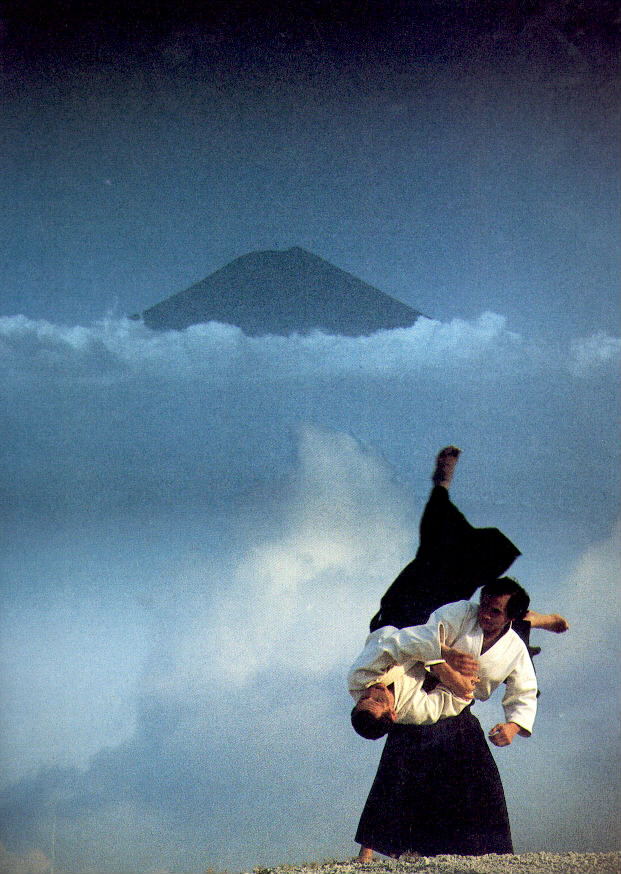
For about a year in the 1980s I studied the martial art aikido, founded in the twentieth century by Japanese master Morihei Ueshiba. Contrary to first appearances, aikido is consistent with a commitment to the Quaker testimony of Peace, because it rejects all forms of attack; its deepest object is to prevent aggression or turn it aside and cause it to cancel itself out. Incorporating some techniques from earlier martial arts, Ueshiba developed it after having a powerful mystical experience of light and unity.
All Eastern martial arts presuppose a worldview in which powerful energy (chi or ki, from which comes the Star Wars concept of the Force) flows throughout the universe, through all things and beings. Consciously or unconsciously, humans can direct the flow of ki by their intentions, whether for creative or healing purposes, or for destruction. An aggressor, being unaware of the inner oneness of all beings, will direct ki together with physical violence against another to injure or overcome him or her. The intended victim is likely to react with fear and/or hostility, and try to fight back in some way, resulting in a painful clash of energies and bodies. According to aikido theory, such clashes are out of keeping with the inner nature of the universe.
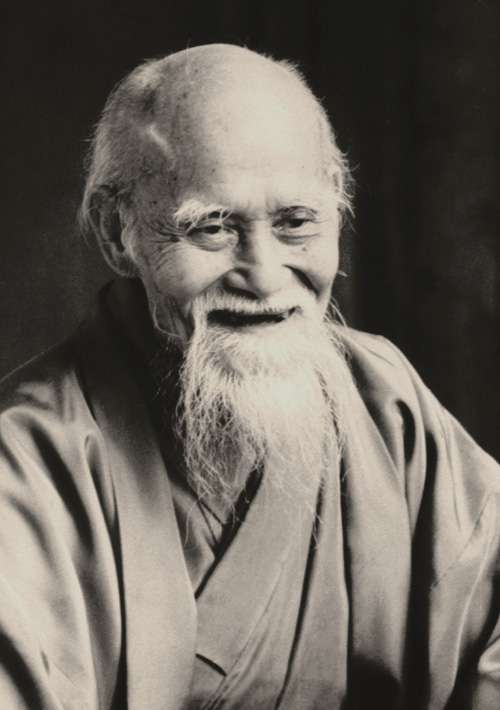 Aikido offers another way to deal with aggression. The practitioner must learn, in deep meditation, to realize his or her oneness with all beings, to overcome all fear and thus be completely relaxed. For some, this process may take decades. One also learns ways to channel ki and ways to maneuver one's body in order to avoid clashes. Not all practitioners aim for these ideals, of course; a person bent on aggression can misuse Aikido techniques. But the deepest intent of the system is to realize, and help one's "opponent" realize, that aggression is self-defeating, ideally so that all will look for a better way.
Aikido offers another way to deal with aggression. The practitioner must learn, in deep meditation, to realize his or her oneness with all beings, to overcome all fear and thus be completely relaxed. For some, this process may take decades. One also learns ways to channel ki and ways to maneuver one's body in order to avoid clashes. Not all practitioners aim for these ideals, of course; a person bent on aggression can misuse Aikido techniques. But the deepest intent of the system is to realize, and help one's "opponent" realize, that aggression is self-defeating, ideally so that all will look for a better way.
To this end, one of the principles I was taught was informally called "See it my way" (although perhaps it should have been "I see it your way"). In real-life threatening situations, an aikidoist at the highest spiritual level will intuit that the other's tension and anger are rising, and will defuse them or leave, so that there is no violence. In the play-acting setting of the dojo or studio, when one practitioner attacks another from the front or side, the one targeted learns to make a lightning turn or half-turn so that s/he is facing the same direction as the attacker (literally seeing the scene his/her way), and actually join the other in his thrust of ki. Simultaneously, the defender may take an appropriate hold of the attacker. Without the expected collision, the attacker is likely to go down of his/her own momentum. The holds enable the defender to pin the attacker to the mat, not with physical strength but by taking advantage of certain weakness of human hands and arms, so that s/he cannot get free without acknowledging that the attack has failed (signaled by slapping the mat with a free hand.) The skilled defender may be quite small and slight, the attacker large and strong; it is not size or muscle power but skill and the use of ki that make the difference.
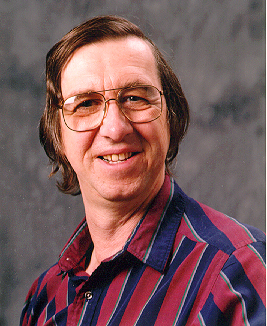 Verbal Aikido
Verbal Aikido
That the principle of "see it my way" offers a useful image for dealing with verbal attack as well I learned from parapsychologist and consciousness researcher Charles
T. Tart. As a frequent lecturer on psychic subjects, Tart would sometimes be verbally attacked by audience members who probably found the topic frightening, but hid their anxiety from themselves by taking a hostile stance. "Before I had studied Aikido," says Tart, "my reaction to an attack in a lecture question was to counterattack. I would expose logical flaws in my attacker's thinking, and/or show he was ignorant of the facts, and/or shower him with high-status scientific facts to demonstrate to him the error of his ways. I would usually "win" the argument, for I was an expert in the subject matter compared to almost all questioners, and a skilled debater. This also made me popular with most of the audience . . . . I fought force with greater force."
Reflecting on the basic principles of aikido, Tart realized that despite the success of his aggressive reaction he was in fact failing, particularly in regard to the supposed opponent, to achieve his central object of communicating knowledge and insight. Choosing instead to apply the "see it my way" principle, he asked himself: What do I and this hostile person have in common? One thing is a shared desire to know the truth and not be deceived. We both want to feel good about our tenets; neither of us wants to be anxious, or defeated, or humiliated. So, instead of hitting back, how can I reply to emphasize what we share? How can I speak out of our underlying oneness? This new approach may not immediately convince the questioner of Tart's position, but it is not only more charitable, it increases the chance that the other will begin to relax her or his fears, and open her mind to the subject later.
 Citing the inspiration of judo, a forebear of aikido, philosopher Bernard Rollins exemplifies the "see it my way" principle in his account of a presentation he made to a group of ranchers in the town of Kiowa, Colorado. When he was introduced, the audience launched into a rude chorus of boos, whistles and foot-stamping. He managed to get their attention by surprising them with a macho response. Then he posed two questions: "Do you guys believe in right and wrong?" The response was a "Hell, yes, this is Kiowa, not New York." The second question was, in effect, "Would you do anything to an animal to increase productivity, even torture her, like sticking hot needles into a cow's eyes?" And the answer came back just as resoundingly, "Hell, no."
Citing the inspiration of judo, a forebear of aikido, philosopher Bernard Rollins exemplifies the "see it my way" principle in his account of a presentation he made to a group of ranchers in the town of Kiowa, Colorado. When he was introduced, the audience launched into a rude chorus of boos, whistles and foot-stamping. He managed to get their attention by surprising them with a macho response. Then he posed two questions: "Do you guys believe in right and wrong?" The response was a "Hell, yes, this is Kiowa, not New York." The second question was, in effect, "Would you do anything to an animal to increase productivity, even torture her, like sticking hot needles into a cow's eyes?" And the answer came back just as resoundingly, "Hell, no."
When Rollins used this Platonic strategy of bringing to their consciousness their own implicit ethic of decency and fairness, their hostility vanished. What followed was a discussion that went on for four hours, in which the audience at one point volunteered information on various abuses that disturbed them. It climaxed in an apology and an invitation to speak at the annual Farm Bureau banquet! Rollins had not turned them into abolitionists, but he had established communication and got them interested in co-creating a welfarist ethic that, in the (very) long run, may eventually lead to abolition. He compares this approach to the process in the U.S. whereby the implicit commitment to human equality--enshrined in the Declaration of Independence in 1776--was the foundation for the eventual passage of laws prohibiting human slavery and racial and sexual discrimination.
A further example: in her recent book Thanking the Monkey (see review below), on page 18, Karen Dawn operates similarly when she gives an example of how one can reply to defenders of vivisection in order to show up unsuspected commonalities. She points out that we can agree that it is natural to care most about our own, especially our own family members. Then she poses a number of cases: would we sacrifice the life of a neighbor's child to save our own child's life? Many of us might be tempted, but there are laws against it. Would we sacrifice the other child's life to save our child's eyesight? Our child's leg? Her kidney? To save our child the pain of an appendectomy? The answer is more and more likely to become "no" from virtually everyone.
Second Thoughts About Rats
When "our own" are humans in general and the "other's child" is an animal, there will still be areas of agreement. Those who profit from animal experiments like to represent animal activists as cranks who prefer rats to children, and many of the public unthinkingly take it up. But, says Dawn, it's not just about painless tests on rats that will surely cure cancer on humans. Almost anyone would kill a rat to save her/his child. How about killing a dog for that reason? But would you kill thousands of rats to produce a new cold medicine that lasts eight hours rather than six? To produce a new cold medicine because the drug company can no longer make money on the one whose patent is expired? The companies do these things, and unknowing people buy the products. At this point not only will virtually everyone who isn't profiting agree, but they will feel a shared indignation at the callousness and greed of the few.
The many drastic disagreements between animal defenders and those who use animals as tools for human benefit, pleasure, or aggrandizement have not gone away, nor has the suffering of the victims. Nor has the obligation of animal defenders to bring that suffering to light. But we can remember to "see it their way," to speak and act out of the conviction that there is That of God, the seed of decency, fairness, and love, in our "opponents." Then clashes may diminish and the animals' Declaration of Emancipation come a little closer.
--Gracia Fay Ellwood
The quotation from Charles T. Tart is from the online essay "Harmony, Defense, and Subtle Energies: Aikido and the Concept of Ki." The citation from Bernard E. Rollins is from pp. 40-43 of Animal Rights and Human Morality, second edition.
We invite responses to editorials or any other feature of PT for our next issue's letter column: graciafay@gmail.com.
Gems
"The whole earth is my home . . . . I have been freed from all desire, not only for position, fame or wealth but also for power. I have understood that the true martial art does not consist of bringing down the enemy by force, nor is it a means to destroy the world with arms . . . It means accepting the spirit of the universe, spreading peace throughout the world, speaking truth, protecting and honoring all natures's creatures . . . .
The way of the true martial art is to make the heart of the universe one's own heart."--Transliterated from the Japanese of Morihei Ueshiba, Founder of Aikido
News Notes
A Conscientious Goat: "That's My Job."
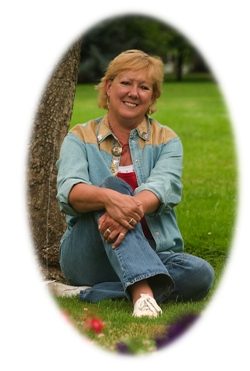 A rancher asked animal communicator Shirley Scott for help in understanding the strange behavior of a goat. She explained to Shirley that every morning the goat put his nose on top of each chicken's head, one at a time, then went nose to nose with each horse, cat, dog, and pig. He repeated his strange behavior again just before nightfall.
A rancher asked animal communicator Shirley Scott for help in understanding the strange behavior of a goat. She explained to Shirley that every morning the goat put his nose on top of each chicken's head, one at a time, then went nose to nose with each horse, cat, dog, and pig. He repeated his strange behavior again just before nightfall.
Shirley reported, "I sent him a message and he walked over to me and wanted me to put my nose next to his. I did and I immediately got this question 'Are you okay?' in my head. I answered that I was, and he backed away. I asked him if this is what he did to the other animals. 'Yes," he said, 'I make sure everyone is okay. That's my job and I do it every day.'
The rancher laughed, but validated the message with a story. She told Shirley about a time when the goat came running and making all kinds of noise. She followed him and saw that the cat had fallen into the pool. "Come to think about it, whenever anything goes wrong around here he's the first one to let us know." Shirley told her "That is his job and he loves it."
--Suzan Vaughn
published in Species Link magazine, Winter 2009, issue #73, "Featured Animal Communicator Shirley Scott" by Suzan Vaughn. www.specieslinkjournal.com; www.animaltalk.net.
Lab-Grown Meat Soon?
A nonprofit research consortium called New Harvest is advocating for the use of lab-grown fish, chicken, and pork. They claim that in vitro meat would slow the spread of diseases (avian influenza, salmonella, etc.) and lessen the meat industry’s negative effects on the environment. They hold that this lab-grown meat (which already exists) may appear on the market in as few as five years, mainly in the form of hamburgers and chicken nuggets. Perhaps the major challenge to marketing it is reducing the cost of production. (It is also necessary to develop a tissue-growing culture that uses no animal products.) See nymag.com/news/features/all-new/53367
--Contributed by Lorena Mucke
Readers are invited to comment on the wisdom or desirability of marketing lab-grown meat.
Welfarist Heads Office of Information and Regulatory Affairs
 President Barack Obama has appointed animal advocate Cass Sunstein to head the Office of Information and Regulatory Affairs, which is responsible for regulatory agencies such as such as the Environmental Protection Agency (EPA). Sunstein, a vegetarian but not an abolitionist, co-authored the book Animal Right: Current Debates and New Directions, and has advocated for stricter regulations of industries that use animals, including entertainment, clothing, science and agriculture. He holds that animals are entitled to representation in court, an idea generally considered revolutionary. To read the full article see planetsave.com/blog/2009/01/19/is-there-a-vegan-in-the-white-house-peta-rejoice
President Barack Obama has appointed animal advocate Cass Sunstein to head the Office of Information and Regulatory Affairs, which is responsible for regulatory agencies such as such as the Environmental Protection Agency (EPA). Sunstein, a vegetarian but not an abolitionist, co-authored the book Animal Right: Current Debates and New Directions, and has advocated for stricter regulations of industries that use animals, including entertainment, clothing, science and agriculture. He holds that animals are entitled to representation in court, an idea generally considered revolutionary. To read the full article see planetsave.com/blog/2009/01/19/is-there-a-vegan-in-the-white-house-peta-rejoice
--Contributed by Lorena Mucke
British Supermarket Chain Forswears Battery Eggs
After February 5, three years before a European Union (EU) ban on battery-produced eggs comes into force, Sainsbury’s will only sell eggs from uncaged birds. This supermarket chain will thus become the first of the big four in Britain to do so. Sainsbury's said more than half a million hens would no longer be kept in battery cages while 2.5 million fewer battery-farmed eggs would go on sale each week in the UK. Their decision follows similar moves by Marks & Spencer, Waitrose, and the Co-op.
Sainsbury's also aims to stop using battery eggs as ingredients in its own-label food and drink by 2012.
--Contributed by Marian Hussenbux
British Hospitals Urged to Offer Veg Meals
Given the concern of greenhouse gases emission around the globe, the National Health Service (NHS) in the UK is urging hospitals to offer meat-free menus, as well as other initiatives, as part of a strategy to cut global warming emissions. Dr David Pencheon, director of the NHS sustainable development unit, said that the amount of NHS emissions meant it had to act to make cuts, and that the changes would also save money, which could be spent on better services for patients. To read the full article see www.guardian.co.uk/society/2009/jan/26/hospitals-nhs-meat-carbon
--Contributed by Lorena Mucke
Letters
Dear Peaceable Friends,
 What an inspiring story of sweet and strong Rambo! I like the way it is his assertiveness and attentiveness that distinguish him, bringing more diversity to stories about what wonderful potential animals have. I also loved the Bible quotes from Job and Matthew, and Barbara Booth's Pilgrimage piece.
What an inspiring story of sweet and strong Rambo! I like the way it is his assertiveness and attentiveness that distinguish him, bringing more diversity to stories about what wonderful potential animals have. I also loved the Bible quotes from Job and Matthew, and Barbara Booth's Pilgrimage piece.
And I want to make that chocolate pie when I finish my qualifying exams!!
--Fay Elanor Ellwood
Dear Peaceable Friends,
Adult mammals have a variety of characteristics developed as a result of their internal re-evaluations of their own development from birth. The intelligence thus developed includes both a sense of justice and the experience of compassion. Many mammals seem to "accept" predators and the nature of the food chain in their habitat. Emotional illness and mental illness create problems among most mammals. During the middle ages, there was a town in Belgium that made an effort to provide compassionate and loving acceptance for humans having emotional or mental illnesses. Rambo was able to outgrow his rage and emotional illness only because of the loving acceptance and compassion shown toward him. Having experienced compassion, Rambo was capable of showing compassion. Billions need to read the Rambo story concerning the contagiousness of compassion.
--John Ewbank
Dear Peaceable Friends,
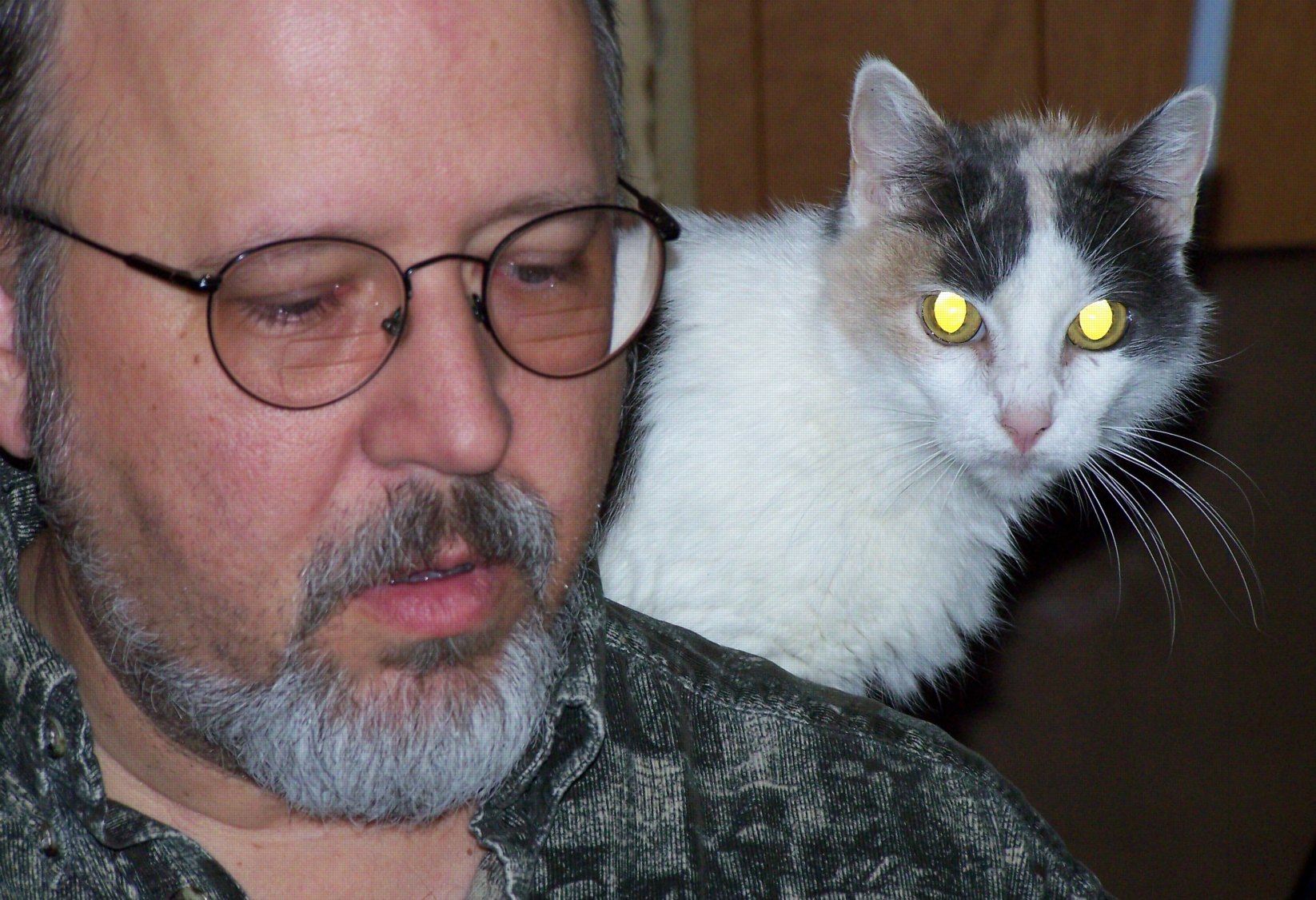 Thank you so much for sharing that wondrous story of this remarkable, clever ram. As a pet guardian, I've always known animals were special companions for us humans, so I'm not completely surprised by Rambo's insight and care for others. But it's always good to hear of others' experiences to reinforce that knowledge.
Thank you so much for sharing that wondrous story of this remarkable, clever ram. As a pet guardian, I've always known animals were special companions for us humans, so I'm not completely surprised by Rambo's insight and care for others. But it's always good to hear of others' experiences to reinforce that knowledge.
I'd like to reprint this story on my own blog step-carefully.blogspot.com . . . .
--Bob Collins, with cat assistant Cookie
Dear Peaceable Friends,
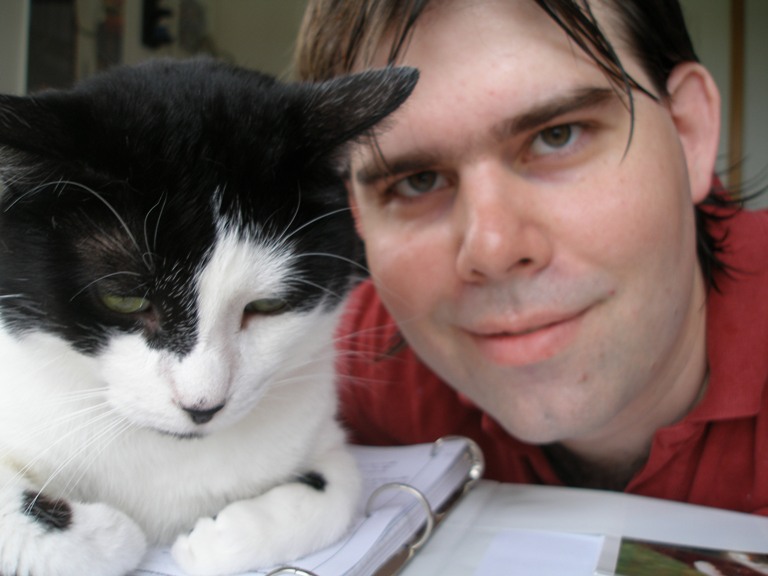 I've enjoyed keeping up with your newsletter, and especially appreciated the articles on the aggressive ram and on soy in the last issue.
I've enjoyed keeping up with your newsletter, and especially appreciated the articles on the aggressive ram and on soy in the last issue.
--Ben De Vries with cat friend Bubba
www.notonesparrow.com
Ben's Pilgrimage story will appear in the March PT.
Dear Peaceable Friends,
There's just something about . . . the way you weave various ideas into your theme, that made me really enjoy "Wound Round with Mercy" [Dec. issue]. I liked your admittance, acceptance, and persevering attitude about the realities of establishing a truly compassionate society, and "that Love transcends our individual efforts to realize love." . . . .
The review on Alex and Me was enlightening to me. I'd never heard of Alex and I was amazed, especially the story about his saying "Calm down" . . . . I greatly enjoyed the article on Rambo the Sheep in the Jan. issue. As with Alex, it shows how animals are much more advanced in thoughts and emotions than most people care to realize.
I wish you peace . . . and pray that your laudable efforts on behalf of the innocents gain success, even if it's one person's heart at a time.
--Carl Sheppard
X28160 62106L
Reception Medical Center / West Unit
P. O. Box 628
Lake Butler, FL 32054-0628
Carl welcomes snail-mail correspondence with other ethical vegetarians.
Dear Peaceable Friends,
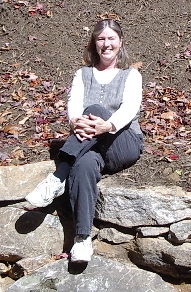 It's very cold here today (last night it snowed), and I find myself thinking about the vegan rice pudding recipe by Angela Suarez that was in the December issue of PT. Might I have permission to put the recipe and photo in the next issue of the Brevard Friends Meeting [N. Carolina] newsletter, along with a credit? Not only is the dish perfect for winter weather, but I'm also keeping the subject of compassion for animals visible in every issue.
It's very cold here today (last night it snowed), and I find myself thinking about the vegan rice pudding recipe by Angela Suarez that was in the December issue of PT. Might I have permission to put the recipe and photo in the next issue of the Brevard Friends Meeting [N. Carolina] newsletter, along with a credit? Not only is the dish perfect for winter weather, but I'm also keeping the subject of compassion for animals visible in every issue.
In the meantime, I think I'll make the pudding tonight as a personal treat!
Angela is really a talented and creative cook! I've been enjoying her recipes and am so glad she's a regular contributor to PT. At least one other person in Brevard Meeting has also been trying out Angela's recipes; could be she'll turn vegetarian one of these days . . .
--Carol Hoke
Dear Peaceable Friends,
Greetings and thanks to all of you for The Peaceable Table. Regarding the review of Jenny McCarthy's book on autism: the link below will take you to the New York Times health section. This article addresses the mistaken idea that vaccinations are the cause of autism. The pediatrician featured in the article is a scientist who has examined this issue carefully . . . . Vegan is not a synonym for anti-science. Vegans need to carefully align themselves with good science and the scientific method. I hope that persons interested in this issue will read Paul A. Offit’s book Autism’s False Prophets. See www.nytimes.com/2009/01/13/health/13auti.html
--Ken Christianson
Readers please note that individual contributors' views on vaccinations are their own, and not part of PT policy. PT's concern is with the claimed dairy connection, which, according to the NY Times article, is also rejected by Offit in his book.--Editor
Book Review: Thanking the Monkey
Karen Dawn, Thanking the Monkey: Rethinking the Way We Treat Animals. New York: HarperCollins Publishers, 2008. Paperback, $19.95.
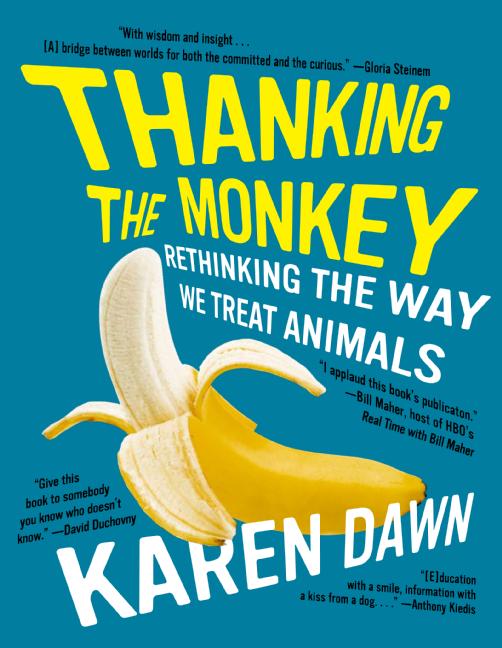 Last December, Gracia Fay and I had the privilege of hearing Karen Dawn read from and discuss this book at the Animal Acres sanctuary . While this was no doubt a "preaching to the choir" setting (and the "choir" included Emily and Brucella, whom Karen had ransomed from a poultry market shortly before Thanksgiving), we were all highly impressed by Karen's enthusiasm and charisma. She is an inspiring and charming person to be with. Moreover, she comes across as equally scintillating and insightful in the book.
Last December, Gracia Fay and I had the privilege of hearing Karen Dawn read from and discuss this book at the Animal Acres sanctuary . While this was no doubt a "preaching to the choir" setting (and the "choir" included Emily and Brucella, whom Karen had ransomed from a poultry market shortly before Thanksgiving), we were all highly impressed by Karen's enthusiasm and charisma. She is an inspiring and charming person to be with. Moreover, she comes across as equally scintillating and insightful in the book.
Not that Thanking the Monkey slides over the bad stuff. As all of us know, there is plenty of misery and pain in the animal world, much of it human-caused. This author presents it plainly, often in wrenching detail. Yet it is frequently relieved by amusing yet pointed cartoons, such as those from "Bizarro" and "Mutts," by telling anecdotes, and by celebrity photos and stories. This is the most "reader friendly" book on animal concerns I've ever seen. It would be the ideal first book on the topic to give to someone who's beginning to open up to the subject.
That reader will wince amidst the fun, though. Karen Dawn deals with virtually all the current animal issues: pets, pet food, pet breeding, goldfish and tropical fish, rodeos and circuses, zoos, marine parks, cinema, fur industries, leather, factory farming, slaughterhouses, honey, hunting, animal experimentation. She goes on to discuss animals and ecology, together with the role government and the media can play. At the end of the book is a list of recommended resource groups.
After reading Dawn's impassioned accounts of numerous animal abuses and highly supportive reports on groups in opposition to them, some readers may be surprised at the moderate tone of her concluding remarks. She is well aware that, for all sorts of reasons, not everyone can or will go all the way all at once. Even if a person is prepared to do only one thing, such as giving up red meat or no longer patronizing entertainments that abuse animals, that is of value. She has seen too many people try to be totally vegan, find it too hard, then go back to "bacon double cheeseburgers made with factory farmed pork." She adds, "That's crazy! It comes from the rigid idea that if one isn't totally vegan, one isn't helping at all, so one might as well just do nothing -- and that isn't true." (p. 347) 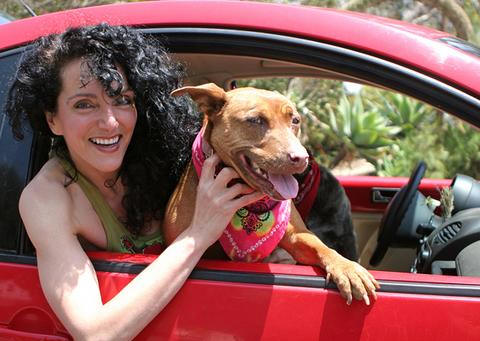 Dawn acknowledges that she herself, while committed to veganism, is occasionally "flexitarian" if it will help the cause. For example, she will order a veggie burger in a mainstream restaurant even if it may contain traces of egg or cheese. Though she would actually prefer a salad, she acts to encourage sales of the veggie burgers and thus ensure they are kept on the menu. She may then suggest to the manager they carry more such vegetarian offerings. An abolitionist, she is also a pragmatist.
Dawn acknowledges that she herself, while committed to veganism, is occasionally "flexitarian" if it will help the cause. For example, she will order a veggie burger in a mainstream restaurant even if it may contain traces of egg or cheese. Though she would actually prefer a salad, she acts to encourage sales of the veggie burgers and thus ensure they are kept on the menu. She may then suggest to the manager they carry more such vegetarian offerings. An abolitionist, she is also a pragmatist.
Many readers may find this outlook sensible. The object, of course, is not some ideal of perfect personal purity but whatever it takes to reduce, and finally eliminate, all human-caused animal suffering, and that for many will mean one step at a time. But readers of Thanking the Monkey are likely to want to make these steps big ones, and to encourage others to take them too.
Highly recommended.
--Robert Ellwood
A Glimpse of the Peaceable Kingdom
Bella and Tara are two best-girlfriends at the Elephant Sanctuary in Tennessee. Aside from both having four legs and a tail, they don't look at all alike--but they see no problem with that. While one of them was "hospitalized" in the office for weeks, the other proved her devotion. See www.youtube.com/watch?v=cBtFTF2ii7U
--Contributed by Virginia Iris Holmes and Barbara Booth
Film Review: The Tale of Despereaux
The Tale of Despereaux. A computer-animated film from Universal Studios, rated G. Directed by Sam Fell and Rob Stevenhagen. Based on the book by Kate Di Camillo. Matthew Broderick as Despereaux, Dustin Hoffman as Roscuro, Emma Watson as Princess Pea, Robbie Coltrane as Gregory the Jailer.
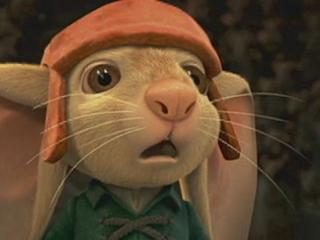 During a major celebratory feast, Roscuro the Rat accidentally falls into the queen's soup. The shock of this gives Her Majesty a fatal heart attack, causing the grieving widower king to outlaw both soup and rats. The king's deep sorrow, and his unjust laws, turn the kingdom into a gloomy place, where it is always cloudy but never rains. In this sad nation is born Despereaux, a little mouse with big ears and a giant soul. He has gallantry, goodheartedness and gravitas. If he had been born in Narnia, and were bigger, he would certainly have a place in Captain Reepicheep's company of brave swordmice. Alas, in the society of bourgeois mice where he is born, timidity is the most priced value and our hero is a total misfit. Can a tiny outcast save a doomed Princess and a cursed Kingdom? Well, not all by himself, but maybe with the help of friends from the Animal, Human and Magical realms.
During a major celebratory feast, Roscuro the Rat accidentally falls into the queen's soup. The shock of this gives Her Majesty a fatal heart attack, causing the grieving widower king to outlaw both soup and rats. The king's deep sorrow, and his unjust laws, turn the kingdom into a gloomy place, where it is always cloudy but never rains. In this sad nation is born Despereaux, a little mouse with big ears and a giant soul. He has gallantry, goodheartedness and gravitas. If he had been born in Narnia, and were bigger, he would certainly have a place in Captain Reepicheep's company of brave swordmice. Alas, in the society of bourgeois mice where he is born, timidity is the most priced value and our hero is a total misfit. Can a tiny outcast save a doomed Princess and a cursed Kingdom? Well, not all by himself, but maybe with the help of friends from the Animal, Human and Magical realms.
The movie, I regret to say, disappointed me in some ways. The story moves too slowly for me, after the fast-paced film Bolt (reviewed in the Jan. issue) . I found both the inflicting and the lifting of the curse a bit hard to believe. Worst of all, as I am a total ailurophile (fanatic lover of cats), I found the one cat in the story quite unappealing both visually and in other ways.
Nevertheless, I do recommend this film, especially for younger children and for people who appreciate fine animated art. Despereaux is a lovable hero, and every hair on his cute little face is lovingly rendered by the animators. And - though I am bit ashamed to admit it, I really liked the deep dark nasty underworld of the rats, with all its barbarism, brutality and vulgarity, and its shameless joie de vivre.
Some important insights may be derived: A whole species should not be judged by the sins or errors of one member. Friendship has great redemptive power. And so does a good story. Like his cousin Reepicheep, Despereaux loves to read and to tell a romantic tale--one that can transform, and even save, lives.
Benjamin Urrutia
Film Review: Hotel for Dogs
Hotel for Dogs. A 2009 film directed by Thor Freudenthal, based on the book by Lois Duncan. Starring Emma Roberts as Andi (age 16), Jake Austin as Bruce (age 11), Don Cheadle as Bernie Wilkins.
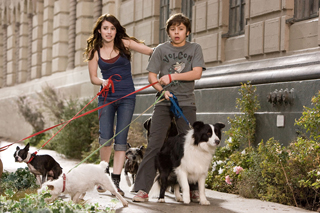
Andi and Bruce are orphans living with their fifth set of unsympathetic foster parents. Mr. Wilkins, their very kind (saintly, in fact) social worker moves heaven and earth to keep them together. Even he does not know they secretly take care of a dog, Friday. Friday finds two dogs living in an abandoned hotel, and the kids decide to help Friday and his new friends stay there. Fortunately, Bruce is a brilliant inventor and creates devices to feed, walk, etc., a whole tribe of canines - which becomes necessary when more refugees check in. Three teens join the gang and help willingly. But dogs, unfortunately, bark, the secret is eventually discovered, and the movie changes from unbelievable comedy to all too real tragedy. All the dogs are hauled off to the local pound, which is a death camp for dogs - except that the jack-booted fascist guards are scruffier (and more bribable and outsmartable). Then the film becomes an action thriller with a daring mass escape reminiscent of that from the Third Reich death camp Sobibor. In its final and fourth phase, the film becomes a Triumph of the Human and Canine Spirit, with Don Cheadle reprising his part from Hotel Rwanda. Here also he is fighting against massacre.
I whole-heartedly recommend this movie for all children and adults, for all people who love dogs--and those who don't, hoping they will change their minds. The movie is not just entertainment, though it is very entertaining. It is also a plea to take action to save homeless dogs, and to rebel against authority when authority is committing cruel injustice.
-Benjamin Urrutia
Recipes
Frozen-Tomato Soup
serves 6
6 large frozen whole tomatoes
1 large yellow onion, chopped
2 cloves garlic, minced
¼ cup Earth Balance Buttery Spread (½ stick)
1 tsp. crumbled dried thyme
½ tsp. ground cumin
¼ tsp. ground cayenne pepper, or to taste
1 tsp. sea salt, or to taste
2 T. vegan “chicken” broth powder
¼ cup wild rice, rinsed
½ cup quinoa, rinsed
1 cup artichokes (packed in water), coarsely chopped
2 cups cooked chickpeas (garbanzo beans)
1 cup unsweetened rice milk
1 T. organic cornstarch
1 T. nutritional yeast
8 cups water
freshly ground black pepper, to taste
In large soup pot, sauté onion and garlic in Earth Balance until onion is translucent. Add the frozen whole tomatoes, thyme, cumin, cayenne pepper and sea salt. Cook over medium-high heat until tomatoes are thawed and begin to break apart. Once the mixture begins to bubble, add 6 cups water and vegan broth powder. Stir with wooden spoon to dissolve broth powder. Stir in wild rice. Cover and simmer for 40 minutes, until wild rice softens. Next add quinoa and 2 cups more water. Return to boil, then reduce heat to a simmer for 30 minutes. Add chopped artichokes and garbanzo beans, stir and cook for 5 minutes. Meanwhile in a small mixing bowl, whisk cornstarch and nutritional yeast into the rice milk. Stir into the soup. Cook, stirring constantly, for 10 minutes until soup is thickened and warmed thoroughly. Adjust seasonings to taste, grind pepper over soup, and serve immediately.
We were fortunate to have a good harvest of tomatoes from our family garden in the summer of 2008, and I was able to freeze a large portion of them for use during the winter. Some tomatoes were puréed and others were blanched, peeled, and frozen whole. Instead of thawing the tomatoes and adding to a recipe, I developed this recipe to add the tomatoes in the frozen form directly to the soup. This is a rich and delicious soup; I hope you enjoy it as much as my family did on a cold January afternoon.
--- Angela Suarez
Gluten Free Brownies
makes one 9 inch x 9 inch pan
 ¾ cup organic sugar
¾ cup organic sugar
⅓ cup canola or safflower oil
⅓ cup organic fair trade cocoa powder
1 tsp. baking powder
¼ tsp. sea salt
1 ½ tsp. vanilla extract
1 tsp. raspberry or apple cider vinegar
⅓ cup soy milk, plain or vanilla flavor
½ cup white rice flour
¼ cup chickpea flour
¼ cup brown rice flour
¼ tsp. xanthan gum
½ cup pecan or walnut pieces (optional)
Preheat oven to 350° F.
In a medium bowl, with a wooden spoon, stir together canola oil and sugar. Stir in cocoa powder, baking powder, sea salt, vanilla extract, raspberry vinegar and soy milk until smooth. Next stir in the flours and xanthan gum until smooth. Stir in pecans or walnuts. Pour into a 9 inch by 9 inch baking dish that has been coated with non-stick cooking spray.
Bake for 20 minutes, until a toothpick comes out clean. Cool on a baking rack and serve with a non-dairy frozen cream (such as Soy Delicious).
--- Angela Suarez
My Pilgrimage: Betse Fowler Streng
On Becoming a Vegetarian
 Despite being raised in the country in my very young years, feasting on fresh garden foods and organic everything, I hit a snag in my own healthy pattern when I took an oral vaccine for polio at age sixteen and within three hours was hospitalized with an undiagnosed raging fever. Odd that the doctors did not connect my mysterious illness to the vaccine I had ingested a few hours before being stricken. Only years later was it discovered that the damage to my spine had been caused by the ravages of the fever of Bulbar polio. That was the beginning of a great deterioration in my health. I married and had four children in rapid succession, further depleting my own body’s resources. I suffered serious back and spine problems, dependent upon chiropractic adjustments three or more times a week to keep walking. Life at its best was often hard for me.
Despite being raised in the country in my very young years, feasting on fresh garden foods and organic everything, I hit a snag in my own healthy pattern when I took an oral vaccine for polio at age sixteen and within three hours was hospitalized with an undiagnosed raging fever. Odd that the doctors did not connect my mysterious illness to the vaccine I had ingested a few hours before being stricken. Only years later was it discovered that the damage to my spine had been caused by the ravages of the fever of Bulbar polio. That was the beginning of a great deterioration in my health. I married and had four children in rapid succession, further depleting my own body’s resources. I suffered serious back and spine problems, dependent upon chiropractic adjustments three or more times a week to keep walking. Life at its best was often hard for me.
I was a conscientious parent who believed that I fed my family well-balanced meals. We ate the normal meatloaf and potatoes diet of the average American family, with far too little attention paid to fruits, vegetables and raw foods. As much as I always loved and revered animals, even pigs on the farm, I was never fond of meat at all, but dutifully prepared it as this was the recommended /accepted/conventional way to feed one’s family well. How slow we are to stop and think for ourselves!
My husband was diagnosed with lymphoma in his mid-fifties. He refused all intervention by the orthodox medical world, as he had studied in depth the lack of success and the horrors of the side effects of such treatments. My chiropractor of twenty-five years, Dr. Helen Fair, had told me to call an old patient of hers, Sam Wesley (pseudonym), a wealthy Texas rancher near Houston, for advice if my husband’s diagnosis were positive. Dr. Fair said, “I don’t know what kind of medicine it is Sam uses, but I do know that he had pancreatic cancer thirty years ago and is well today.”
Within minutes of receiving the medical report (three months to live without chemotherapy, or six months or more with it) and my husband’s adamant refusal of all therapies, I was on the telephone with Sam Wesley. That man was wonderful! The different kind of medicine that he used was homeopathic medicine. Our changeover to that vibrational form of medicine was also a pivotal point in our lives. Sam gave me a list of books to read and poured out marvelous dietary advice for two hours. I will be forever grateful to him for caring so much. The first thing he told me was: “You’ve got to make a radical dietary change. No meat or fish or poultry, and spend at least 6 months detoxifying the body on raw foods only. Nothing cooked. No salt. No animal products of any kind. Only raw, fresh, and as organic as possible live food!” We stayed on raw for a year. It was the healthiest, happiest and probably most productive year of our lives. My health soared, for I was in critical condition myself when the tumor appeared on my husband’s leg, and I insisted he have a biopsy. (I would not do that now, since I no longer have any fear at all of that or any disease. It is the fear that buys us into the system and can ultimately wreak its own havoc in our lives on every level--emotional, mental, physical and spiritual. [I forgot to say financial as well! It is tremendously profitable business.] )
My husband survived three of the healthiest years of his life on that marvelous diet. My own health soared to heights never before known. I threw away a metal back brace I had worn for 25 years. I walked a 180 mile pilgrimage with the Indians. I climbed to the first level of Kilimanjaro! I had never dreamt life could be so fun-filled and adventurous.
I stayed a vegan for eleven years but not on raw food that long, My decision against meat was an intellectual one; it simply takes far more enzymatic action to digest and assimilate animal products than fresh plant food. The enzymatic action that works on the food is also important to our immune system. If our soldiers are tied up making mush from the steak we ate, they cannot come to the body’s aid in illness. It not only made sense to me intellectually, I was living proof that the change had been ultra-dramatically good for me. (I quit a 30 year nicotine addiction overnight without a single withdrawal problem That may seem abnormal, but my adrenaline was running full speed ahead on Survival.)
My cellular structure must have changed also on every level, because in time I came to wonder how in the world I had ever been able to eat the meat from a living animal or fish or bird. The very idea itself became as repugnant to me as if one suggested I eat baby fingers. And it remains so to this day.
My whole view of Life and the magnificent world in which we live seemed to come into sharp focus for the first time. I am unable to step on a bug or spider, snail, scorpion . . . anything . . . for I have come to realize the magnificent balance of things as given to us by a far greater architect than ourselves.
Once we overcome our own fears we see the world from a new (and unadvertised) perspective. It is a beautiful world when we are living in harmony with all of Life.
"A Pocket Full of Rye," Betse's animal-friendly version of the nursery rhyme "Sing a Song of Sixpence," can be seen in PT29.
Pioneer: Peter Singer, 1946-
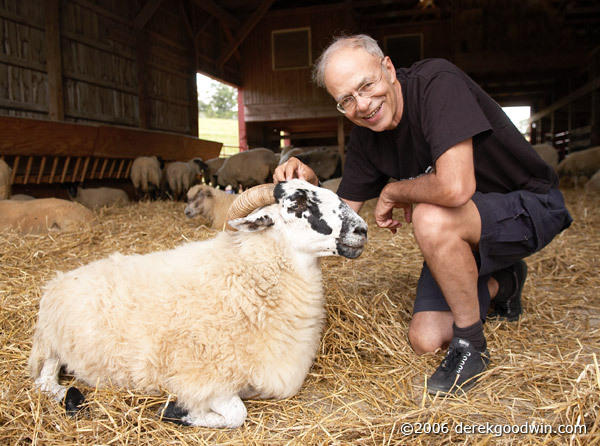 Ethics philosopher Peter A.D. Singer (not to be confused with Peter W. Singer of the Brookings Institute) was born in Melbourne, Australia, of Viennese Jewish parents who had escaped from the Nazis in 1938 after the German invasion of Austria. His father's parents and his mother's father, however, died in concentration camps. This devastation of the family was surely traumatic for his parents, and may well have been so indirectly for their two children as well.
Ethics philosopher Peter A.D. Singer (not to be confused with Peter W. Singer of the Brookings Institute) was born in Melbourne, Australia, of Viennese Jewish parents who had escaped from the Nazis in 1938 after the German invasion of Austria. His father's parents and his mother's father, however, died in concentration camps. This devastation of the family was surely traumatic for his parents, and may well have been so indirectly for their two children as well.
Singer received his BA from the University of Melbourne in 1967, and his MA in ethics in 1969. He then then received a scholarship to study further at Oxford University in 1970. As he relates it in Animal Liberation, here he and his wife Renata became friendly with fellow students Richard Keshen and Stanley and Rosalind Godlovitch, and Keshen's wife Mary. During lunch with Keshen, Singer inquired why Keshen was a vegetarian, and was favored with an account of some of the conditions under which farmed animals were raised. A meal featuring meat (Singer said elsewhere that he was eating a hamburger) is considered by some to be among the worst situations for a vegetarian to speak up about farmed animals, because meat-eaters will become even more defensive than usual. Fortunately for the future of the animal cause, Singer was remarkably free of such defensiveness, and he wanted to hear more.
As these conversations among the three couples continued into 1971, Singer was impressed by his friends' ethical position, particularly well articulated by Rosalind Godlovitch. He "became convinced that by eating animals I was participating in a systematic form of oppression of other species by my own species." With the support and encouragement of Renata, Singer put his mouth where his convictions were, and became vegetarian.
About two years later the Godlovitches and colleague John Harris published an anthology entitled Animals, Men, and Morals delineating their position. This work would probably have had little or no influence in the United States had not Singer sent a review of it to the New York Review of Books. To his surprise, not only was the review published (April, 1973), it aroused a considerable stir. Riding this breaker of interest, Singer wrote his landmark Animal Liberation, which appeared in 1975. Just as Ruth Harris' Animal Factories had opened the doors of the malodorous industry to the public in 1965 Britain, Singer's book did likewise for the U.S.
The book's title was chosen to highlight the link to earlier calls for liberation. The title of chapter one is "All Animals are Equal . . . or why the supporters of liberation for Blacks and women should support Animal Liberation too." Developing the analogy, he submits that to the wrongs of "racism" and "sexism" corresponds the wrong of "speciesism" (a term coined by activist Richard Ryder). Speciesism, he explains, is a "bias toward the interests of members of one's own species and against those of members of other species" (p. 7). Being able to feel pain and pleasure is a prerequisite for having interests; a dog has an interest in not being kicked, but a rock has no such interest. As a utilitarian, Singer holds that the interests of all beings capable of suffering and pleasure are worthy of equal consideration. That does not mean all should have the same treatment, since needs and interests differ to some extent. In the context of ethics, the concept of the equality of beings does not depend on factual evidence of parity; it is not a description of their characteristics but a moral prescription of how they should be treated.
In accordance with utilitarianism's ideal of bringing about the greatest good for the greatest number, Singer is willing to allow that at times causing harm to certain animals may be justified if an unmistakable greater good to humans results. He holds, however, that eating animals, especially in the context of industrial agribusiness, is far from being justified by the pleasures that humans may derive from it. It is morally wrong.
Reading about the terrible and unjustifiable suffering that factory-farmed animals endure at the hands of humans (as his book describes them) is emotionally wrenching, and rightly so, says Singer. However, he is clear that his central appeal is not to emotions but to reason, emphasizing that the cuteness or cuddliness of animals is not relevant to the issue. "When the United States Defense Department finds that its use of beagles to test lethal gases has evoked a howl of protest and offers to use rats instead, I am not appeased (p. xi)."
Some animal defenders take issue with elements of Singer's analysis, particularly his rather contemptuous dismissal of "sentimental appeals for sympathy." But there is widespread agreement that his work is probably the primary factor that put concern for animals on the map in many areas of public life, particularly in the United States.
--Gracia Fay Ellwood
Poetry: Walter de la Mare, James Russell Lowell
The Captive
I twined a net; I drove a stake; I laid a glittering bait.
With still of dewfall stepped my prey; cried--and cried too late.
I clutched him by his golden curls: I penned his flutterings,
Secure within a golden cage he beats in vain his wings.
But why is now their beauty gone
From woods where once it happy shone?
Why is my bosom desolate,
When entering in at fall of eve,
I listen at the wicket gate
And hear my captive grieve?
--Walter de la Mare
From The Vision of Sir Launfal
. . . . Not only around our infancy
Doth heaven with all its splendors lie;
Daily, with souls that cringe and plot,
We Sinais climb and know it not.
Over our manhood bend the skies;
Against our fallen and traitor lives
The great winds utter prophecies;
With our faint hearts the mountain strives;
Its arms outstretched, the druid wood
Waits with its benedicite;
And to our age's drowsy blood
Still shouts the inspiring sea . . . .
--James Russell Lowell
The Peaceable Table is
a project of the Animal Kinship Committee of Orange Grove Friends Meeting, Pasadena, California. It is intended to resume the witness of that excellent vehicle of the Friends
Vegetarian Society of North America, The Friendly
Vegetarian, which appeared quarterly between 1982 and
1995. Following its example, and sometimes borrowing from its
treasures, we publish articles for toe-in-the-water
vegetarians as well as long-term ones, news notes, poetry, letters, book
and film reviews, and recipes.
The journal is intended to be
interactive; contributions, including illustrations, are
invited for the next issue. Deadline for the March issue
will be Feb. 26, 2009. Send to graciafay@gmail.com
or 10 Krotona Hill, Ojai, CA 93023. We operate primarily
online in order to conserve trees and labor, but hard copy
is available for interested persons who are not online.
The latter are asked, if their funds permit, to donate $12 (USD) per year. Other
donations to offset the cost of the domain name and server are welcome.
Website: www.vegetarianfriends.net
Editor: Gracia Fay Ellwood
Book and Film Reviewers: Benjamin Urrutia & Robert Ellwood
Recipe Editor: Angela Suarez
NewsNotes Editors: Lorena Mucke and Marian Hussenbux
Technical Architect: Richard Scott Lancelot Ellwood

 Aikido offers another way to deal with aggression. The practitioner must learn, in deep meditation, to realize his or her oneness with all beings, to overcome all fear and thus be completely relaxed. For some, this process may take decades. One also learns ways to channel ki and ways to maneuver one's body in order to avoid clashes. Not all practitioners aim for these ideals, of course; a person bent on aggression can misuse Aikido techniques. But the deepest intent of the system is to realize, and help one's "opponent" realize, that aggression is self-defeating, ideally so that all will look for a better way.
Aikido offers another way to deal with aggression. The practitioner must learn, in deep meditation, to realize his or her oneness with all beings, to overcome all fear and thus be completely relaxed. For some, this process may take decades. One also learns ways to channel ki and ways to maneuver one's body in order to avoid clashes. Not all practitioners aim for these ideals, of course; a person bent on aggression can misuse Aikido techniques. But the deepest intent of the system is to realize, and help one's "opponent" realize, that aggression is self-defeating, ideally so that all will look for a better way. Verbal Aikido
Verbal Aikido Citing the inspiration of judo, a forebear of aikido, philosopher Bernard Rollins exemplifies the "see it my way" principle in his account of a presentation he made to a group of ranchers in the town of Kiowa, Colorado. When he was introduced, the audience launched into a rude chorus of boos, whistles and foot-stamping. He managed to get their attention by surprising them with a macho response. Then he posed two questions: "Do you guys believe in right and wrong?" The response was a "Hell, yes, this is Kiowa, not New York." The second question was, in effect, "Would you do anything to an animal to increase productivity, even torture her, like sticking hot needles into a cow's eyes?" And the answer came back just as resoundingly, "Hell, no."
Citing the inspiration of judo, a forebear of aikido, philosopher Bernard Rollins exemplifies the "see it my way" principle in his account of a presentation he made to a group of ranchers in the town of Kiowa, Colorado. When he was introduced, the audience launched into a rude chorus of boos, whistles and foot-stamping. He managed to get their attention by surprising them with a macho response. Then he posed two questions: "Do you guys believe in right and wrong?" The response was a "Hell, yes, this is Kiowa, not New York." The second question was, in effect, "Would you do anything to an animal to increase productivity, even torture her, like sticking hot needles into a cow's eyes?" And the answer came back just as resoundingly, "Hell, no."
 A rancher asked animal communicator Shirley Scott for help in understanding the strange behavior of a goat. She explained to Shirley that every morning the goat put his nose on top of each chicken's head, one at a time, then went nose to nose with each horse, cat, dog, and pig. He repeated his strange behavior again just before nightfall.
A rancher asked animal communicator Shirley Scott for help in understanding the strange behavior of a goat. She explained to Shirley that every morning the goat put his nose on top of each chicken's head, one at a time, then went nose to nose with each horse, cat, dog, and pig. He repeated his strange behavior again just before nightfall. President Barack Obama has appointed animal advocate Cass Sunstein to head the Office of Information and Regulatory Affairs, which is responsible for regulatory agencies such as such as the Environmental Protection Agency (EPA). Sunstein, a vegetarian but not an abolitionist, co-authored the book Animal Right: Current Debates and New Directions, and has advocated for stricter regulations of industries that use animals, including entertainment, clothing, science and agriculture. He holds that animals are entitled to representation in court, an idea generally considered revolutionary. To read the full article see
President Barack Obama has appointed animal advocate Cass Sunstein to head the Office of Information and Regulatory Affairs, which is responsible for regulatory agencies such as such as the Environmental Protection Agency (EPA). Sunstein, a vegetarian but not an abolitionist, co-authored the book Animal Right: Current Debates and New Directions, and has advocated for stricter regulations of industries that use animals, including entertainment, clothing, science and agriculture. He holds that animals are entitled to representation in court, an idea generally considered revolutionary. To read the full article see  Thank you so much for sharing that wondrous story of this remarkable, clever ram. As a pet guardian, I've always known animals were special companions for us humans, so I'm not completely surprised by Rambo's insight and care for others. But it's always good to hear of others' experiences to reinforce that knowledge.
Thank you so much for sharing that wondrous story of this remarkable, clever ram. As a pet guardian, I've always known animals were special companions for us humans, so I'm not completely surprised by Rambo's insight and care for others. But it's always good to hear of others' experiences to reinforce that knowledge. Last December, Gracia Fay and I had the privilege of hearing Karen Dawn read from and discuss this book at the Animal Acres sanctuary . While this was no doubt a "preaching to the choir" setting (and the "choir" included Emily and Brucella, whom Karen had ransomed from a poultry market shortly before Thanksgiving), we were all highly impressed by Karen's enthusiasm and charisma. She is an inspiring and charming person to be with. Moreover, she comes across as equally scintillating and insightful in the book.
Last December, Gracia Fay and I had the privilege of hearing Karen Dawn read from and discuss this book at the Animal Acres sanctuary . While this was no doubt a "preaching to the choir" setting (and the "choir" included Emily and Brucella, whom Karen had ransomed from a poultry market shortly before Thanksgiving), we were all highly impressed by Karen's enthusiasm and charisma. She is an inspiring and charming person to be with. Moreover, she comes across as equally scintillating and insightful in the book. Dawn acknowledges that she herself, while committed to veganism, is occasionally "flexitarian" if it will help the cause. For example, she will order a veggie burger in a mainstream restaurant even if it may contain traces of egg or cheese. Though she would actually prefer a salad, she acts to encourage sales of the veggie burgers and thus ensure they are kept on the menu. She may then suggest to the manager they carry more such vegetarian offerings. An abolitionist, she is also a pragmatist.
Dawn acknowledges that she herself, while committed to veganism, is occasionally "flexitarian" if it will help the cause. For example, she will order a veggie burger in a mainstream restaurant even if it may contain traces of egg or cheese. Though she would actually prefer a salad, she acts to encourage sales of the veggie burgers and thus ensure they are kept on the menu. She may then suggest to the manager they carry more such vegetarian offerings. An abolitionist, she is also a pragmatist. During a major celebratory feast, Roscuro the Rat accidentally falls into the queen's soup. The shock of this gives Her Majesty a fatal heart attack, causing the grieving widower king to outlaw both soup and rats. The king's deep sorrow, and his unjust laws, turn the kingdom into a gloomy place, where it is always cloudy but never rains. In this sad nation is born Despereaux, a little mouse with big ears and a giant soul. He has gallantry, goodheartedness and gravitas. If he had been born in Narnia, and were bigger, he would certainly have a place in Captain Reepicheep's company of brave swordmice. Alas, in the society of bourgeois mice where he is born, timidity is the most priced value and our hero is a total misfit. Can a tiny outcast save a doomed Princess and a cursed Kingdom? Well, not all by himself, but maybe with the help of friends from the Animal, Human and Magical realms.
During a major celebratory feast, Roscuro the Rat accidentally falls into the queen's soup. The shock of this gives Her Majesty a fatal heart attack, causing the grieving widower king to outlaw both soup and rats. The king's deep sorrow, and his unjust laws, turn the kingdom into a gloomy place, where it is always cloudy but never rains. In this sad nation is born Despereaux, a little mouse with big ears and a giant soul. He has gallantry, goodheartedness and gravitas. If he had been born in Narnia, and were bigger, he would certainly have a place in Captain Reepicheep's company of brave swordmice. Alas, in the society of bourgeois mice where he is born, timidity is the most priced value and our hero is a total misfit. Can a tiny outcast save a doomed Princess and a cursed Kingdom? Well, not all by himself, but maybe with the help of friends from the Animal, Human and Magical realms. 
 ¾ cup organic sugar
¾ cup organic sugar Despite being raised in the country in my very young years, feasting on fresh garden foods and organic everything, I hit a snag in my own healthy pattern when I took an oral vaccine for polio at age sixteen and within three hours was hospitalized with an undiagnosed raging fever. Odd that the doctors did not connect my mysterious illness to the vaccine I had ingested a few hours before being stricken. Only years later was it discovered that the damage to my spine had been caused by the ravages of the fever of Bulbar polio. That was the beginning of a great deterioration in my health. I married and had four children in rapid succession, further depleting my own body’s resources. I suffered serious back and spine problems, dependent upon chiropractic adjustments three or more times a week to keep walking. Life at its best was often hard for me.
Despite being raised in the country in my very young years, feasting on fresh garden foods and organic everything, I hit a snag in my own healthy pattern when I took an oral vaccine for polio at age sixteen and within three hours was hospitalized with an undiagnosed raging fever. Odd that the doctors did not connect my mysterious illness to the vaccine I had ingested a few hours before being stricken. Only years later was it discovered that the damage to my spine had been caused by the ravages of the fever of Bulbar polio. That was the beginning of a great deterioration in my health. I married and had four children in rapid succession, further depleting my own body’s resources. I suffered serious back and spine problems, dependent upon chiropractic adjustments three or more times a week to keep walking. Life at its best was often hard for me. Ethics philosopher Peter A.D. Singer (not to be confused with Peter W. Singer of the Brookings Institute) was born in Melbourne, Australia, of Viennese Jewish parents who had escaped from the Nazis in 1938 after the German invasion of Austria. His father's parents and his mother's father, however, died in concentration camps. This devastation of the family was surely traumatic for his parents, and may well have been so indirectly for their two children as well.
Ethics philosopher Peter A.D. Singer (not to be confused with Peter W. Singer of the Brookings Institute) was born in Melbourne, Australia, of Viennese Jewish parents who had escaped from the Nazis in 1938 after the German invasion of Austria. His father's parents and his mother's father, however, died in concentration camps. This devastation of the family was surely traumatic for his parents, and may well have been so indirectly for their two children as well.